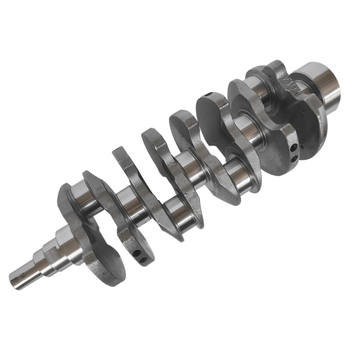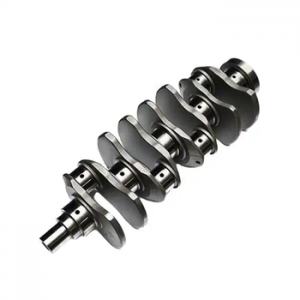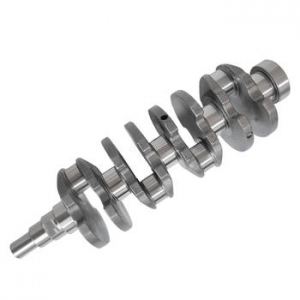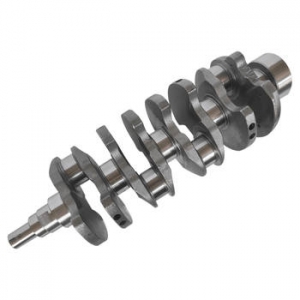The Heart of the Engine: A Deep Dive into Crankshaft Manufacturing
Have you ever stopped to think about the symphony of controlled explosions happening inside an internal combustion engine? At the very center of that mechanical ballet, translating the violent, linear motion of the pistons into the smooth, rotational force that turns the wheels, lies a component of incredible strength and precision: the crankshaft. Frankly speaking, it's the backbone of the engine. But how is this critical part made? The process of crankshaft manufacturing is a fascinating journey of brute force and microscopic precision, a blend of ancient metallurgy and modern robotics. It's far more complex than many people realize.
In this guide, we'll pull back the curtain on this essential industrial process. We'll explore everything from the raw materials that form its foundation to the high-tech machining that gives it its final shape. Whether you're an automotive enthusiast, an engineering student, or simply curious about the marvels of modern manufacturing, get ready for a deep dive into the world of the crankshaft.
The Foundation: Materials and Design Considerations
Before a single chip of metal is cut, the life of a crankshaft begins on a designer's screen and as a carefully selected alloy. The choices made at this stage dictate the component's strength, longevity, and ultimately, the engine's performance and character. It’s not a one-size-fits-all situation; the crankshaft for a daily commuter car is fundamentally different from one destined for a top-fuel dragster.
Choosing the Right Metal: A Tale of Two Materials
The selection of the base material is the first critical decision. The choice primarily boils down to two families of metals, each with distinct properties, costs, and manufacturing methods. The different types of crankshaft materials directly influence the subsequent manufacturing steps.
- Cast Iron: For the vast majority of production passenger cars and light trucks, ductile cast iron is the material of choice. It’s created by pouring a molten iron alloy into a mold. The primary advantages are cost-effectiveness and excellent vibration-damping characteristics, which contribute to a smoother, quieter engine operation. It's also relatively easy to cast into complex shapes. However, its tensile strength is lower than that of forged steel.
- Forged Steel: When high performance, extreme stress, and maximum durability are the goals, forged steel is the undisputed king. The process involves taking a solid billet of steel (often a high-carbon or alloy steel like 4340 chromoly) and hammering or pressing it into shape. This process aligns the grain structure of the metal, resulting in a component that is significantly stronger and more resistant to fatigue and torsional stress. In my experience, for any serious racing or heavy-duty diesel application, forged steel is the only way to go.
The Blueprint for Power: Crankshaft Design Principles
A crankshaft's design is a masterclass in mechanical engineering. Every curve, journal, and counterweight is meticulously planned to manage immense forces and maintain a delicate balance.
- Journals: These are the precision-machined cylindrical surfaces. The main journals run along the centerline of the crank and sit in the engine block's main bearings, allowing the entire assembly to rotate. The rod journals (or crankpins) are offset from the centerline and are where the connecting rods attach. The distance of this offset, known as the "throw," determines the engine's stroke and, consequently, its displacement.
- Counterweights: These are the large lobes opposite the rod journals. Their purpose is critical: they offset the mass of the piston and connecting rod assembly as it flies up and down. Without properly engineered counterweights, an engine would vibrate itself to pieces in short order.
- Oil Passages: Interestingly enough, a crankshaft is not a solid piece of metal. A network of internal passages is drilled through it to carry high-pressure oil from the main journals to the rod journals, ensuring the bearings are constantly lubricated. This is a life-or-death feature for an engine.

From Billet to Blank: The Forging and Casting Processes
Once the design is finalized and the material is selected, the raw metal must be formed into a rough "crankshaft blank." This initial shaping is accomplished through either forging or casting, a pivotal step that defines the component's internal structure and inherent strength.
The Art of Forging: Hammering Steel into Shape
The crankshaft forging process is a display of immense power and heat. It begins with a steel billet, a simple cylindrical or rectangular bar, heated in a furnace to around 1200°C (2200°F). At this temperature, the steel becomes plastic and malleable.
The glowing-hot billet is then placed in a massive press containing a set of dies. These dies are two halves of a mold, precision-machined with the negative impression of the crankshaft's shape. The press then slams the dies together with thousands of tons of force, squeezing the hot steel and forcing it to flow into every cavity of the die. This is often done in several stages, with different dies refining the shape progressively. The key benefit here is the refinement of the metal's grain structure. The forging process forces the grains to align with the shape of the part, creating a continuous flow that greatly enhances its strength and fatigue resistance, especially in the critical fillet areas where the journals meet the webs.
The Precision of Casting: Pouring Molten Metal
Casting offers a less forceful, but no less precise, alternative. For a cast iron crankshaft, a special blend of iron, carbon, silicon, and other elements is melted in a furnace. Simultaneously, a mold is created, typically from a mixture of sand and a bonding agent. The mold is made in two halves (the "cope" and "drag") and contains the exact shape of the desired crankshaft, including the internal passages for oil, which are formed by inserting sand "cores."
The molten iron is then poured into the mold and left to cool and solidify. Once solid, the sand mold is broken away, revealing the rough crankshaft casting. While it doesn't have the aligned grain structure of a forged part, modern casting techniques like using ductile iron (which contains small spherical graphite nodules) produce parts with excellent properties for most automotive applications at a significantly lower cost than forging.
The Heart of the Matter: Precision Machining Operations
Whether forged or cast, the blank that emerges is still a rough, oversized, and imprecise version of the final product. The next stage is where the magic truly happens. The journey through the various crankshaft machining operations is what transforms the rough blank into a component with tolerances measured in ten-thousandths of an inch.
Roughing It Out: Initial Machining Steps
The first step is to establish accurate reference points. The blank is mounted in a specialized CNC (Computer Numerical Control) lathe or milling center. Powerful cutting tools begin to remove large amounts of material, a process known as "roughing."
The main journals and pin journals are turned to get them close to their final diameter. The faces of the counterweights, the snout (front end), and the flywheel flange (rear end) are milled flat. At this stage, the focus is on speed and material removal, bringing the part closer to its net shape while leaving a small amount of material for the finishing operations.
The Finer Details: Drilling and Grinding
With the rough shape established, the focus shifts to precision. One of the most critical operations is drilling the oil passages. This is often done using a technique called "gun drilling," which uses a long, straight-fluted drill bit and high-pressure coolant to produce a very straight and deep hole. These passages must intersect perfectly to ensure an uninterrupted flow of oil.
Next comes grinding. The journals, which are the bearing surfaces, must be perfectly round and have an incredibly smooth surface finish to minimize friction. The crankshaft is mounted in a cylindrical grinder, a machine that uses a large abrasive wheel spinning at high speed to remove minute amounts of material. This process allows for the achievement of extremely tight dimensional and geometric tolerances. The surface finish is critical; any imperfections could disrupt the oil film and lead to catastrophic engine failure.

Achieving Perfect Balance: Dynamic Balancing
It's worth noting that even with perfect machining, a crankshaft will not be perfectly balanced out of the box. Minor variations in material density or geometry can create an imbalance that would cause destructive vibrations at high RPMs. To correct this, the crankshaft is placed in a dynamic balancing machine. It's spun at a specific speed while sensors measure any wobble or vibration. A computer analyzes this data and indicates exactly where material needs to be removed and how much. The operator then drills shallow holes into the counterweights at these precise locations to remove mass, bringing the entire rotating assembly into perfect balance. This is a non-negotiable step for a smooth and reliable engine.
Strengthening and Finishing: The Final Touches
A perfectly shaped and balanced crankshaft is still not ready for an engine. The surfaces, especially the journals, need to be hardened to withstand millions of cycles of wear and tear. This is where heat treatment and final finishing processes come in.
Building Resilience: Heat Treatment Processes
To make the bearing surfaces durable, they undergo a localized hardening process. Two common methods are:
- Induction Hardening: An electromagnetic coil is placed around a journal. A high-frequency alternating current is passed through the coil, which induces eddy currents in the surface of the steel, rapidly heating it. Once it reaches a critical temperature, it is immediately quenched (rapidly cooled) with a spray of water or polymer. This creates a very hard, wear-resistant "case" on the surface while leaving the core of the crankshaft tough and ductile.
- Nitriding: This is a chemical hardening process. The crankshaft is placed in a sealed furnace, and the atmosphere is filled with nitrogen-rich gas (like ammonia) at a high temperature for an extended period (often 24 hours or more). Nitrogen atoms diffuse into the surface of the steel, forming hard nitride compounds. Nitriding creates a thinner but typically harder and more durable case than induction hardening and has the added benefit of causing less distortion.
The Final Polish: Surface Finishing and Inspection
After hardening, the journals often receive a final micro-polishing or superfinishing treatment. This uses fine abrasive tape or stones to smooth the surface to a mirror-like finish, further reducing friction and improving bearing life.
Finally, every single crankshaft undergoes a rigorous quality control inspection. Dimensions are checked with high-precision instruments like Coordinate Measuring Machines (CMM). The entire part is subjected to non-destructive testing, such as magnetic particle inspection, where the part is magnetized and coated with fluorescent iron particles. Any surface cracks or flaws will disrupt the magnetic field and show up as glowing lines under a UV light, ensuring that no defective parts ever leave the factory. This comprehensive approach to quality is a cornerstone of modern crankshaft manufacturing.
The Future of Crankshaft Manufacturing
The world of manufacturing is never static, and the production of crankshafts is no exception. While the fundamental principles remain, technology is constantly pushing the boundaries of what is possible in terms of performance, efficiency, and precision.
Innovations on the Horizon
Many experts agree that we are on the cusp of several exciting developments. Advanced materials, such as metal matrix composites or even titanium for cost-no-object racing applications, are being explored to reduce rotational mass further. Advances in 5-axis CNC machining and intelligent automation are reducing cycle times and improving consistency. While full-scale additive manufacturing (3D printing) of production crankshafts is still some way off due to material strength and cost limitations, it is already being used to create complex casting patterns and functional prototypes with incredible speed.
Sustainability and Efficiency
There is also a growing focus on making the manufacturing process more sustainable. This includes developing more energy-efficient furnaces and machining processes, optimizing tool paths to reduce material waste, and improving recycling methods for metal scraps and cutting fluids. As the automotive industry continues to evolve, so too will the methods used to create its most vital components.
The crankshaft is a testament to human ingenuity—a component born from fire, force, and phenomenal precision. The complex dance of metallurgy, mechanical engineering, and quality control that defines its creation is what allows our engines to perform reliably day in and day out. So, the next time you turn the key and hear your engine roar to life, perhaps you'll have a new appreciation for the incredible heart of the machine, spinning thousands of times a minute, right at its core. What other "simple" mechanical parts do you think have a surprisingly complex manufacturing story?
For more detailed information, please visit our official website:Crankshaft manufacturing
About the author: Dr. Alistair Finch is a senior manufacturing engineer with over 25 years of experience in the automotive and aerospace industries. Specializing in high-performance engine components and advanced metallurgy, he has published numerous papers on forging technologies and CNC machining optimization. When he's not in the lab or on the factory floor, Alistair enjoys restoring classic European sports cars, where he gets to appreciate the engineering of a bygone era firsthand.
 Crankshaft Distributor: The Un
Crankshaft Distributor: The Un
 The Ultimate Guide to Sourcing
The Ultimate Guide to Sourcing
 Power Your Business: A Deep Di
Power Your Business: A Deep Di
 Choosing the Right Crankshaft
Choosing the Right Crankshaft
